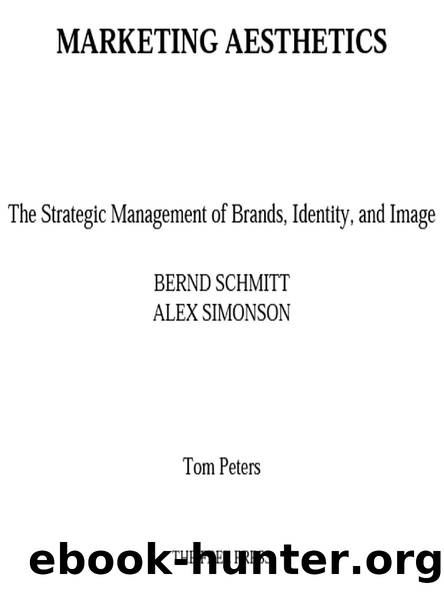MARKETING AESTHETICS by BERND SCHMITT & ALEX SIMONSON

Author:BERND SCHMITT & ALEX SIMONSON
Language: eng
Format: epub
Publisher: THE FREE PRESS
Published: 1997-07-15T00:00:00+00:00
APPLICATION: DIESEL
Diesel is Europe’s hottest marketer of jeans. Diesel sales worldwide grew from $9 million in 1985 to $350 million ten years later. Its goal is to push U.S. sales ($15 million in 1995) to $100 million by 1999. 9 Diesel uses a hybrid approach of avant-garde and “retro” that is evident throughout its entire identity.
The quirky and satirical Successful Living advertising campaign, a product of Swedish ad firm Paradiset, was started in 1991 and has been run internationally ever since. The fall 1997 campaign takes a look back at significant moments in history. The campaign, shot in Miami, takes actual historical situations and transforms them in a witty way, using the latest computer technology to generate new images on older material (see Exhibit 6.3). Diesel’s retail stores in Berlin, London, Paris, New York, Washington, Chicago, and San Francisco create an atmosphere that is “futuristic with quirky retro accents—brightly lacquered fixtures, fake-wood paneling, space-age metal and vintage furniture from the sixties and seventies.” The clothing itself is also a hybrid of avant-garde and “retro.” The fall/winter 1997 men’s collection includes “gothic-inspired,” “punk,” and a “motor” theme. The women’s collection incorporates a variety of classic materials of this century, such as tweed, nylon, angora wool, cotton, satin, and velvet as well as new materials such as “super-soft stretch ultrasuede,” “striped gabardine,” and “techno vinyl.”
Legacy. A legacy impression is created when the company or brand is endowed with a sense of history or a sense of past time that is projected into the future. The customer should be familiar enough with the company history to find the historical approach plausible and persuasive. In 1996, Siemens, a German supplier of over 700 systems and products from fuel injectors and microprocessors to halogen headlamps, ran legacy ads, spreading over two pages, that stressed the history of the company and its future. (“1908. That was then. 1996. This is now.”)
Sonae, a company in Portugal, used an interesting legacy approach to launch its new logo and corporate identity. Sonae was founded in 1959 and pioneered the production of decorative laminates. It soon broadened its range of wood products, and in the 1980s expanded into supermarkets, real estate, information technology, leisure, and tourism. Its average annual growth rate in the 1980s was 38%. In the early 1990s it chose a new logo that symbolizes growth and energy. The logo represents the nurturing and development of new businesses and is accompanied by the slogan “from the smallest seed into the largest tree.” Sonae thus makes appropriate reference to its beginnings in wood products and uses this symbolic representation to lead itself to the future. 10
Classic. A classic impression implies that something lasts, endures, and is of permanent value. The judgment of whether an identity is classic or timeless changes over time. To put it differently, the impression of being classic is created at a certain point in time. An organization can only achieve a classic impression over time if it updates parts of its aesthetic occasionally. Especially if
Download
This site does not store any files on its server. We only index and link to content provided by other sites. Please contact the content providers to delete copyright contents if any and email us, we'll remove relevant links or contents immediately.
| Advertising | Consumer Behavior |
| Customer Service | Marketing |
| Public Relations | Sales & Selling |
| Search Engine Optimization |
Influence: The Psychology of Persuasion by Robert B. Cialdini(4179)
The Miracle Morning by Hal Elrod(3910)
The Hacking of the American Mind by Robert H. Lustig(3580)
Pre-Suasion: A Revolutionary Way to Influence and Persuade by Robert Cialdini(3414)
Unlabel: Selling You Without Selling Out by Marc Ecko(2981)
Hidden Persuasion: 33 psychological influence techniques in advertising by Marc Andrews & Matthijs van Leeuwen & Rick van Baaren(2778)
Who Can You Trust? by Rachel Botsman(2732)
Kick Ass in College: Highest Rated "How to Study in College" Book | 77 Ninja Study Skills Tips and Career Strategies | Motivational for College Students: A Guerrilla Guide to College Success by Fox Gunnar(2720)
Purple Cow by Seth Godin(2698)
Ogilvy on Advertising by David Ogilvy(2682)
I Live in the Future & Here's How It Works by Nick Bilton(2524)
This Is Marketing by Seth Godin(2482)
The Marketing Plan Handbook: Develop Big-Picture Marketing Plans for Pennies on the Dollar by Robert W. Bly(2414)
The Power of Broke by Daymond John(2376)
Building a StoryBrand by Donald Miller(2360)
The 46 Rules of Genius: An Innovator's Guide to Creativity (Voices That Matter) by Marty Neumeier(2310)
Draw to Win: A Crash Course on How to Lead, Sell, and Innovate With Your Visual Mind by Dan Roam(2277)
The Tipping Point by Malcolm Gladwell(2204)
Market Wizards by Jack D. Schwager(2163)
